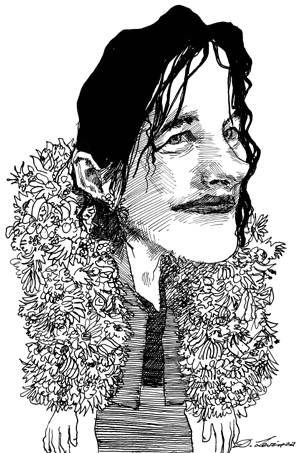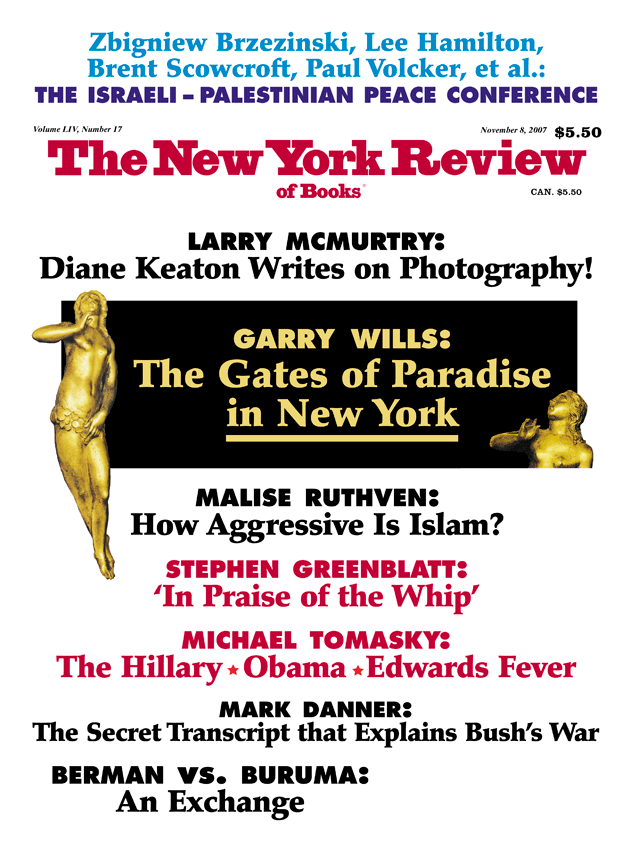The Almost Moon, Alice Sebold’s second novel, is the story of a mother-daughter hate affair. The daughter in question is Helen Knightly, a forty-nine-year-old divorced mother of two who works as a nude artist’s model at a college in a depressed area in central Pennsylvania. Her eighty-eight-year-old mother, who lives nearby in the old family house, is deep into dementia but hasn’t lost her spunk. A passage of dialogue—the first words exchanged between the two women—gives a hint of the emotional weather, and Sebold’s stylized approach to depicting it:
“Mother,” I said, calling the name only I, as her sole child, had the right to call her. She looked up at me and smiled.
“Bitch,” she said.
Things go downhill from there. After her mother soils herself—“Number two!” she cries, as if she’d just won at bingo—Helen tries to clean up the mess but instead finds herself smashing a towel over the old woman’s face, gruesomely snapping her nose. “Within a few minutes,” Helen relates, “as she struggled for breath, my lifelong dream had come true.” A few hours later, so has another fantasy, when Helen goes to seek the help of a friend but instead ends up having sex with the friend’s thirty-year-old son, a motorcycle-riding stud named Hamish, in the backseat of her car. “Morality was just a security blanket that didn’t exist,” she tells herself as the compliant young hunk rips off her underwear. “All of it, what I had done and what I was doing, was not leading me perilously toward the edge of a cliff. I had already jumped.” By this point, so has the novel.
Sebold’s snappily paced, grimly funny opening chapter might have been the windup to a suburban gothic tale of what happens when ordinary murderous feelings meet real-world consequences, with a sharp crime-and-cover-up plot thrown in to boot. Instead, what follows is a sketchily plotted account of the improbable events of the next twenty-four hours, interspersed with flashbacks to Helen’s operatically traumatic childhood. Within hours of the murder, Helen’s ex-husband, a successful artist, arrives like a welcome emissary from the vaguely normal world. They haven’t spoken in years, but he comes running from California, wearing a T-shirt bearing the usefully ironic slogan “Life is good.” (“If there was a reason for our divorce,” Helen quips, “it was this in a nutshell.”) As he tries to help her cover her tracks, Helen digs deeper into memories of life with her gorgon of a mother and her sweet but distant father, who was in and out of mental hospitals until one day he finally just shot himself in the head.
In Lucky, her powerfully blunt memoir of being brutally raped as a college student, Sebold described her passage into a world divided forever after into two territories: “the safe and the not safe.” In Sebold’s novels, violence gives access to a kind of ultimate, mystical truth. “There wasn’t a lot of bullshit in my heaven,” declares Susie Salmon, the fourteen-year-old narrator of Sebold’s bolt-from-the-blue 2002 mega-bestseller The Lovely Bones, who after being raped and dismembered is able to look down on the flawed world with a greathearted stoicism beyond anyone’s years.
In The Almost Moon, Helen, lying in the backseat after her quickie with Hamish, recalls reading one of her own teenage daughter’s lurid true crime books about a serial killer who is finally thwarted by a canny older prostitute. “How can you read such things?” she asks with a prim indignation that hardly squares with anything else she tells us about herself in the course of her explanation of how she came to be standing over her mother’s crumpled body, contemplating how best to chop it up and stuff it into the freezer. “It’s real,” her daughter replies. “There’s no bullshit.” Or, as Helen herself, in a more Keatsian mood, puts it earlier: “Shit is shit and truth is truth.”
The Almost Moon is bent on rubbing the reader’s face in that sort of truth, as recounted by a mugging, self-congratulatory first-person narrative voice that never seems to stop looking out of the corner of its eye to note the reader’s shocked reaction. Sebold almost seems to be writing against the consoling sweetness of The Lovely Bones, with its reassurance that in heaven even dismembered children would get their limbs pieced back together and live, after a fashion, to see some kind of justice done and happiness regained on earth. That book was most persuasive not in its comforting vision of the afterlife but in its dreamy but precise evocation of the closed, ritualistic world of suburban childhood. There, Sebold drew a sharp line between the morbid basement games of children and the sick ceremonies of the murderer next door, with his creepily tidy tract house and collection of tiny dollhouse lintels and wainscoting. But in The Almost Moon, she offers an overcooked vision of hell of the other-people variety, where even the telephone is a deadly weapon—“You’re giving me a grenade?” Helen’s mother asks when she buys her a cell phone—and every kitchen is a bunker where a potential killer waits.
Advertisement
Almost every paragraph of the novel brings some image of menace or torture meant to underscore the mortal dangers of “the emotional hotbeds that were so benignly labeled ‘domesticity,'” in Helen’s clunkily literal phrasing. Lucille Ball’s beehive, on late-night reruns, “was so red and false it looked more like Bozo’s blood sample than Bozo’s wig.” Helen recalls the punishing beauty rituals imposed by her mother, complete with bizarre gothic flourishes generally not specified in women’s magazines: the moisturizer applied nightly to her feet, sealed in with heavy socks secured with ankle weights; the strict reducing diets, supplemented by the notes—“Fuck them!” “Tallyho!”—she would inscribe on carrot discs she then hid inside her mother’s shoes or under her powder puff, “my own dietetic version of the sugar hearts from Valentine’s Day.” Rummaging under her mother’s sink after the killing, Helen finds “enough saved-from-the-grocery plastic containers…to store the hearts and lungs of every citizen along Phoenixville Pike”—the frugal suburban housewife’s stash of recyclables revealed as canopic jars worthy of Jeffrey Dahmer.
Sebold expects us to believe that a young stud would fall into bed with a forty-nine-year-old woman without a moment’s pause—which comes off here as equal parts wishful thinking and contrived plotting, however hard Helen works at “gym crucifixion” to preserve the goods she struts for the art students with the confrontational ferocity of a stripper. But throughout her confession, she dwells almost lovingly on the disgustingness of the aging female body, which is always on the verge of rotting away.
“I had grown used to the smell of her by now, a sort of fecal-mothball combo,” Helen jauntily informs us when she washes her mother’s soiled, mastectomy-scarred corpse. In one of the few scenes of intimate girlfriend-ish sharing she is able to recall, her mother confesses an attempted seduction of a neighbor, explaining that his wife “was in the hospital having a hysterectomy. I offered myself.” There’s a gratuitous recollection of a rectal exam, during which her mother gives a potted lecture on Monticello to the embarrassed young resident. Washing her mother’s dead body, Helen tells us, “This was not the first time I’d been face-to-face with my mother’s genitalia. In the last decade, I had become my mother’s official enema-giver”—as a chaser, she’d go to the kitchen and “scarf…down leftover cubes of lime Jell-O.” At this point, the reader may feel like Helen does when she realizes the trouble she’s in: “If only I could vomit.”
“I’m a real bitch, huh?” Helen says, almost proudly, to Hamish, who reappears in a climactic sequence involving a sex-for-car swap, a stolen gun, a home invasion, and a string of facile epiphanies. But in the end, even she herself doesn’t quite have the stomach for the role. After all the vomit and body parts and tough talk, Sebold’s ending—with its appeals to the idea of a mother’s protective love of her children and a desire to break the cycles of the past—feels like a cop-out, an emotional plea bargain. It’s not clear which version of Helen is the truth—or rather, which version is less convincing: the traumatized bitch-daughter who spreads a chicken breast on the broiler pan and sees her mother’s rotten heart, or the fiercely protective mama bear who only wants to tell her own children the whole truth, no bullshit.
“I’m going to teach you two very important words,” Helen recalls a strange but kindly neighbor telling her after a terrifying childhood encounter with a neighborhood lynch mob riled by her mother’s bizarrely antisocial behavior. “Here they are: fucking bastard.” He also offers another two: “mentally ill.” The novel hangs awkwardly unresolved between these two ideas. Is Helen an avenging survivor—“fearlessly sane,” as her ex-husband puts it? Or has she, the lifelong guardian of her mother’s madness, also crossed over into the realm of the old-fashioned crazy?
In one striking passage, Helen expresses a longing for a kind of comforting bird’s-eye view of human suffering that recalls the heaven of The Lovely Bones, only here that longing is thwarted. “I thought briefly of what an aerial view of our neighborhood would look like with all the roofs sheared off,” Helen says.
Advertisement
In how many houses would happy families be settling in for the night, watching TV with bright bowls of popcorn in their laps?… To take the tops off all the houses and mingle our miseries was too simple a solution, I knew. Houses had windows with shades. Yards had gates and fences. There were carefully planned out sidewalks and roads, and these were the paths that, if you chose to go into someone else’s reality, you had to be willing to walk. There were no shortcuts.
In The Almost Moon, Sebold traps her character in a house of horrors, with no plausible exit and an absurdly overdetermined explanation of how she got there in the first place. Yes, hell is other people. But sometimes all it takes is one.
This Issue
November 8, 2007



